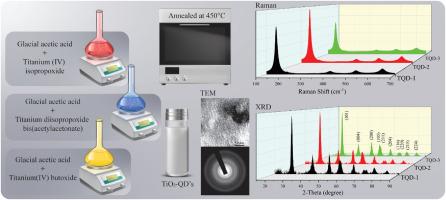Scalable synthesis of anatase titania quantum dots: Precursor influence, formation mechanism, and multifunctional applications
IF 6.8
3区 材料科学
Q1 MATERIALS SCIENCE, MULTIDISCIPLINARY
Journal of Science: Advanced Materials and Devices
Pub Date : 2025-05-25
DOI:10.1016/j.jsamd.2025.100917
引用次数: 0
Abstract
This study demonstrates a straightforward and scalable approach for synthesizing anatase titania (TiO2) quantum dots (QDs) using various titanium precursors. The synthesis employed a simple sol-gel method combined with reflux condensation in an aqueous solution, eliminating the need for templates or organic solvents. A subsequent annealing process resulted in QDs with a high yield exceeding 43 %. The primary objective was to investigate the effects of different precursors on the properties of the QDs and the mechanisms governing their formation. X-ray diffraction (XRD) and transmission electron microscopy (TEM) analyses confirmed that the crystallite size was consistently below 10 nm, with variations influenced by the choice of precursor. The crystalline anatase phase was successfully identified through XRD and Raman spectroscopy. The optical properties of the QDs were studied using UV–Vis–NIR spectroscopy, and the energy bandgap (Eg) was determined to range from 4.04 to 4.08 eV, based on Tauc plot analysis. This value exceeds the typical bandgap of bulk TiO2, a phenomenon attributed to quantum size effects. The findings highlight the potential of this method for producing high-yield TiO2 QDs with tunable properties, paving the way for advancements in applications such as photocatalysis, optoelectronics, and energy storage.

锐钛矿型二氧化钛量子点的可扩展合成:前驱体影响、形成机制和多功能应用
本研究展示了一种使用各种钛前体合成锐钛矿型二氧化钛(TiO2)量子点(QDs)的简单且可扩展的方法。合成采用简单的溶胶-凝胶法结合回流冷凝在水溶液中,消除了模板或有机溶剂的需要。随后的退火工艺得到了产率超过43%的量子点。主要目的是研究不同前体对量子点性质的影响及其形成机制。x射线衍射(XRD)和透射电子显微镜(TEM)分析证实,晶体尺寸始终小于10 nm,其变化受前驱体选择的影响。通过XRD和拉曼光谱成功地鉴定了锐钛矿相。利用紫外-可见-近红外光谱研究了量子点的光学性质,并根据Tauc图分析确定了量子点的能带隙(Eg)在4.04 ~ 4.08 eV之间。该值超过了块体TiO2的典型带隙,这一现象归因于量子尺寸效应。这一发现突出了这种方法在生产具有可调性能的高产TiO2量子点方面的潜力,为光催化、光电子学和储能等应用的进步铺平了道路。
本文章由计算机程序翻译,如有差异,请以英文原文为准。
求助全文
约1分钟内获得全文
求助全文
来源期刊

Journal of Science: Advanced Materials and Devices
Materials Science-Electronic, Optical and Magnetic Materials
CiteScore
11.90
自引率
2.50%
发文量
88
审稿时长
47 days
期刊介绍:
In 1985, the Journal of Science was founded as a platform for publishing national and international research papers across various disciplines, including natural sciences, technology, social sciences, and humanities. Over the years, the journal has experienced remarkable growth in terms of quality, size, and scope. Today, it encompasses a diverse range of publications dedicated to academic research.
Considering the rapid expansion of materials science, we are pleased to introduce the Journal of Science: Advanced Materials and Devices. This new addition to our journal series offers researchers an exciting opportunity to publish their work on all aspects of materials science and technology within the esteemed Journal of Science.
With this development, we aim to revolutionize the way research in materials science is expressed and organized, further strengthening our commitment to promoting outstanding research across various scientific and technological fields.
 求助内容:
求助内容: 应助结果提醒方式:
应助结果提醒方式:


